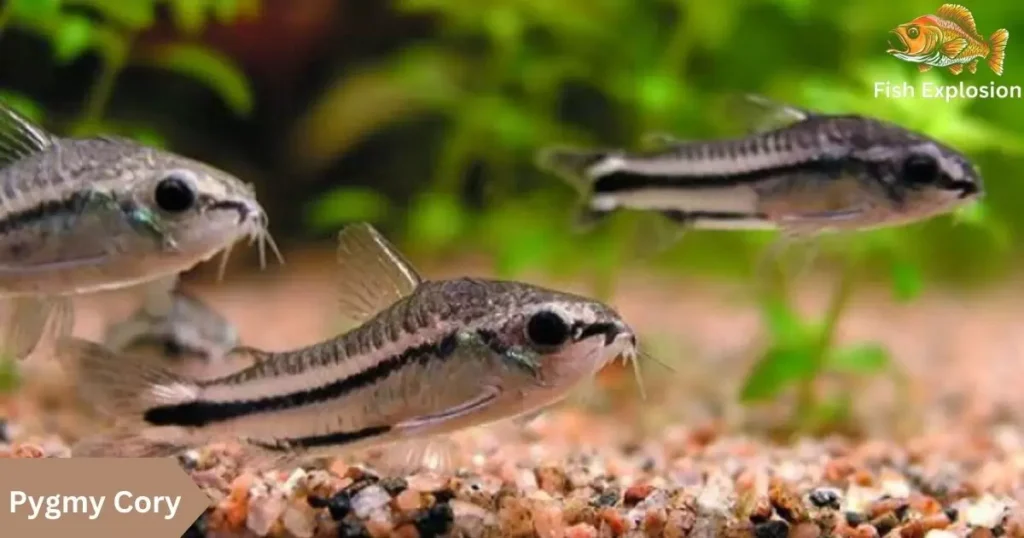Maintaining a balanced and healthy freshwater aquarium environment can be a delicate task, and one of the biggest challenges aquarium hobbyists face is controlling algae growth. While some algae is natural and even beneficial, excessive growth can quickly become unsightly and potentially harmful to the aquatic inhabitants. Fortunately, there are several small and unobtrusive species that can help keep algae levels in check through their natural grazing habits. From the industrious otocinclus catfish to the fascinating amano shrimp, these algae-eating heroes not only serve a practical purpose but also add unique behaviors and vibrant colors to the underwater ecosystem. In this article, we’ll explore ten excellent small algae eaters that can be excellent additions to freshwater aquariums, providing insights into their care, compatibility, and algae-consuming prowess.
Our Top 10 Smallest Algae Eaters

Choosing the right size algae eater is crucial, as some species can outgrow their aquarium unexpectedly. Fortunately, the ten options listed here are true small-scale species, allowing you to introduce efficient algae control without compromising space or balance within your freshwater setup.
Read More: “Green Spotted Puffer: Care, Size, Tank Mates & More”
Amano Shrimp
Amano shrimp (Caridina multidentata) are hardy and peaceful algae eaters native to Japan. These industrious little creatures are highly effective at consuming various types of algae, including hair algae and black beard algae.
Amano shrimp are active grazers, constantly roaming the aquarium in search of their next algae meal. With their unique fan-like appendages and lively movements, they not only serve a practical purpose but also add visual interest to the aquarium.
Blue Dream Shrimp
It is a captivating addition to any freshwater aquarium. With their mesmerizing blue hue and striking white markings, these dwarf shrimp are true showstoppers. Beyond their aesthetic appeal, they are efficient algae grazers that help maintain a balanced ecosystem. Relatively simple to care for, Blue Dream shrimp thrive in well-established tanks with plenty of hiding spots.
Assassin Snails
They are unique invertebrates that serve as formidable pest control in aquariums. As their name suggests, these snails are predators that primarily feed on other snails, making them an excellent solution for controlling unwanted snail populations.
With their distinctive elongated shells and voracious appetites, assassin snails can quickly restore balance to an infested tank. However, caution is advised when housing them with desired snail species.
Mystery Snails
They are a popular choice for freshwater aquariums, known for their quirky personalities and efficient algae-eating abilities. These undemanding snails can grow quite large, reaching sizes of up to 2 inches.
With their varied shell patterns and colors, they add visual interest to any tank. Mystery snails are excellent scavengers, helping to keep the aquarium clean by consuming leftover food and decaying plant matter.
Pygmy Cory

It is an adorable and industrious little catfish that packs a big punch when it comes to algae control. These social bottom-dwellers are best kept in schools, where they’ll spend their days diligently foraging for aufwuchs and other microorganisms. Despite their small size, pygmy corys have big personalities and are a delight to observe as they swim and graze together in the aquarium.
Siamese Algae Eater (requires 20-gallon tank)
- Native to Southeast Asia, particularly the Mekong basin
- Peaceful schooling fish that does best in groups of 5 or more
- Elongated body shape with a distinct suckermouth for grazing algae
- Grows to about 6 inches in length when fully mature
- Requires a well-established aquarium with plenty of algae for grazing
- Prefer planted tanks with driftwood and rocky areas to mimic their natural habitat
- Need excellent water quality and weekly water changes
- May become territorial and aggressive if kept singly or in too small a group
- Not considered a pure herbivore, will also consume protein-based foods
- Minimum tank size of 20 gallons, with larger tanks being better
Otocinclus vestitus
The otocinclus vestitus, commonly known as the dwarf suckermouth catfish, is a popular algae eater for freshwater aquariums. These peaceful bottom-dwellers use their sucker mouths to graze on aufwuchs and diatoms.
With their adorable appearance and maximum size of only 2 inches, otos make excellent additions to nano tanks. However, they require matured aquariums with ample algae growth and driftwood for grazing.
8 Green Kubotai Rasboras
It can be an effective way to control algae while adding a vibrant splash of color. These peaceful cyprinids spend most of their time grazing on algae and biofilm. With their small size, reaching only 1.5 inches, they are well-suited for moderately planted community tanks. Their striking metallic green hue complements lush aquascapes beautifully.
Blue Dolphin Mori Juvenile
It is a fascinating addition to the freshwater aquarium. These small fish boast vibrant neon blue stripes along their elongated bodies. While not true algae eaters, they will graze on aufwuchs and diatoms, helping to control nuisance algae growth.
With their peaceful nature and maximum size of 3 inches, blue dolphin moris make excellent community tank residents.
Female Koi Betta
Female Koi Betta A female koi betta (Betta splendens) can be an attractive and undemanding algae eater for the home aquarium. Unlike their more aggressive male counterparts, female bettas are generally peaceful community fish.
They will readily graze on hair algae and other nuisance algae growth. With their striking marble patterns and maximum length of 3 inches, female koi bettas add both functional and aesthetic value.
Male Koi Betta
They are renowned for their vibrant coloration and elaborate flowing fins. While primarily kept for their ornamental appeal, these labyrinth fish will opportunistically graze on algae in the aquarium.
However, their territorial nature and potential aggression towards other male bettas mean they are best kept singly or in a species tank. When provided with an appropriately sized, planted environment, male koi bettas can make striking algae-eating showpieces.
Nerite Snails
Nerite snails are versatile mollusks known for their striking shell patterns and colors, ranging from brown and green to vivid blacks and yellows. They inhabit marine, freshwater, and brackish environments, playing a crucial role in maintaining ecological balance by feeding on algae, thus keeping aquatic habitats clean and healthy.
Habitat and Distribution
Nerite snails are primarily found in marine environments but can also thrive in freshwater and brackish conditions. They are widespread in various regions, including the Indo-Pacific area, the Caribbean, and parts of the Mediterranean.
Physical Characteristics
These snails are known for their rounded, smooth shells that come in various patterns and colors, such as brown, green, and black. They are small, typically measuring between 1/2 to 1 inch in diameter, making them popular in aquarium settings.
Role in Ecosystems
Nerite snails are important algae grazers, helping to keep aquariums and natural habitats clean by consuming algae on surfaces. Their presence helps maintain ecological balance and can prevent the overgrowth of algae in their environments.
Ramshorn Snail
The Ramshorn Snail is distinguished by its spiraled shell that resembles a ram’s horn, with color variations from red to brown and even blue. These freshwater snails are popular in aquariums for their ability to consume algae, dead plant matter, and leftover food, contributing to the cleanliness and balance of the aquatic ecosystem.
Malaysian Trumpet Snail
Malaysian Trumpet Snails are known for their elongated, conical shells and nocturnal habits. They burrow into the substrate of freshwater habitats, which helps aerate and mix the substrate, preventing the buildup of harmful gases and detritus. These snails are beneficial for aquariums, aiding in nutrient cycling and providing a natural form of waste management.
FAQ’s
What is the smallest freshwater algae eater?
The smallest freshwater algae eater is the Otocinclus catfish, which can grow to about 1-2 inches in length.
What is the best algae eater in a freshwater aquarium?
The best algae eater in a freshwater aquarium is often considered to be the Siamese Algae Eater, due to its efficiency in consuming a wide variety of algae types.
What eats algae in a small tank?
In small tanks, Amano shrimp are effective at eating algae due to their small size and hearty appetite for various algae forms.
What kills algae in freshwater tanks?
Algae in freshwater tanks can be controlled through chemical treatments, UV sterilizers, and the introduction of algae-eating organisms.
Conclusion
Small algae eaters are invaluable for maintaining balance and cleanliness in freshwater aquariums. Among the top choices, Otocinclus catfish, Siamese Algae Eaters, and various types of shrimp, like Amano and Cherry, are renowned for their efficient algae consumption.
Nerite snails, with their diverse shell patterns, also contribute significantly by scraping algae off surfaces. Bristlenose plecos, despite being slightly larger, are favored for their robust algae-eating habits without growing too large. Dwarf suckers and certain types of small barbs offer additional options, targeting different algae types and contributing to the ecosystem’s diversity.
These creatures not only keep the tank clean but also add to its aesthetic appeal and biological diversity. Choosing the right mix of small algae eaters can lead to a healthier, more stable aquarium environment, making it crucial for hobbyists to consider size, compatibility, and specific dietary needs when selecting their aquatic cleaners.
With three years of dedicated expertise in the niche of fish, my domain knowledge encompasses breeding, habitat maintenance, health management, and sustainable aquaculture practices, ensuring optimal outcomes in the aquatic realm.











